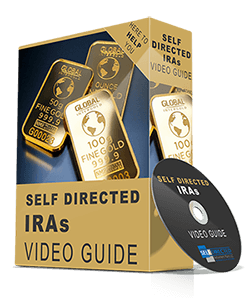Self-Directed Real Estate IRA

But before you start shopping for properties with your retirement funds, there are a few important things to understand. This guide walks you through what a “Self-Directed Real Estate IRA” is, how it works, and whether it’s the right move for you.
What Is a Self-Directed IRA for Real Estate?
A self-directed individual retirement account (IRA) is a kind of retirement account that offers you greater choice over how your money is invested. It allows you to invest your retirement funds in a variety of assets, including private firms, precious metals, real estate, and more. In contrast, a traditional IRA typically restricts you to stocks, bonds, or mutual funds.
What does this signify in terms of real estate? It implies that your IRA is permitted to purchase raw land, rental properties, and even commercial buildings. The asset is owned by the IRA, not by you. Whether you use a standard or Roth SDIRA, you still benefit from tax-deferred or tax-free growth.
Before diving into real estate investing, make sure you understand the fundamentals.
How Does a Self-Directed IRA Work for Real Estate?
The first thing to remember is when you choose a self-directed IRA for real estate, you are in charge of making decisions. Still, legally, the IRA is the owner. That means the deed to the property will be in the name of your IRA, not yours.
The exact steps of how you go about purchasing a property via a self-directed IRA are mentioned in the upcoming section of this blog.
What are the Different Types of Real Estate You Can Invest in With a Self-Directed IRA?
Self-directed IRA for real estate works for so many options, including:-
- ResidentialThe most common types of real estate found in self-directed IRAs are single-family homes and multi-family units. Rental income is generated by renting these properties.
- CommercialCommercial property is another great way to generate long-term rental income. Real estate investments include a broad range, from grocery stores to office buildings to baseball fields.
- Mortgage NotesMortgage Notes are an indirect way to invest in real estate. Real estate lenders can use your savings to help others purchase homes while making a profit for yourself.
- Offshore Real EstateOffshore real estate investments are for investors who want the freedom to invest in foreign real estate markets and to take the tax benefits associated with overseas investments.
- Real Estate Owned PropertiesReal estate-owned (REO) properties are foreclosed properties that the bank has taken back. You can use your self-directed IRA to buy these properties from the bank or the auctions.
Other real estate investments that are allowed with a Self-Directed IRA are:
- Apartment Buildings
- Condominiums Building
- Bonds
- Commercial Paper
- Foreclosures
- Improved or Unimproved Land
- Joint Ventures
- Leases
- Limited Partnerships
- Tangible Asset Deeds
- Tax Lien Certificates
- Trust Deeds
- Limited Liability Companies (LLCs)
How to Buy Real Estate With a Self-Directed IRA
Investing in alternative assets like real estate with your self-directed IRA is similar to a regular real estate purchase. However, there are certain rules and processes you need to follow to do it correctly. Here’s the process of buying real estate with a self-directed IRA
Open and fund an SD IRA account.
Use a qualified self-directed IRA custodian to do this.
Find a property to purchase.
Do your due diligence to identify the property you want to invest in.
Direct your custodian to fund your investment with your account.
Give the specifics of the property to your IRA custodian with information of how much money you need, if documents need signing and where to send the funds. You can either fund the entire purchase or a part of it with your IRA.
Manage the investment in your account.
Since your IRA funded the investment, the money, income, and expenses, has to be to and from the IRA.
How Can You Fund Your Self-Directed IRA Real Estate Purchase?
There are several ways you can invest in real estate with your IRA funds. Here are a few examples:
What Self-Directed IRA Real Estate Rules Do You Need to Follow?
Self-directed IRA real estate investment comes with rules. Breaking them could disqualify your IRA, which would trigger taxes and penalties. Here are the big ones:
- No Personal Use: You, your spouse, or close family can’t live in or vacation at the property.
- No Personal Benefit: You can’t hire yourself or a relative to work on the property.
- No Self-Dealing: You can’t buy the property from or sell it to yourself or a family member.
- No Personal Funds: All income and expenses must be managed through the IRA.
Stick to the rules to stay in good standing with the IRS.
Pros and Cons of Real Estate in a Self-Directed IRA
It sounds cliché, but it’s a fact that every coin has two sides. So, it’s better to weigh both the pros and cons of a real estate IRA before investing. Here they are to help you make a decision:-
Advantages:
- More Control: You choose where your money goes.
- Tax Benefits: Just like traditional IRAs, your earnings grow tax-deferred (or tax-free in a Roth).
- Diversification: Real estate helps balance your portfolio if the stock market is shaky.
- Potential for Passive Income: Rental properties can produce monthly income inside your IRA.
Drawbacks:
- No Personal Benefit: You can’t touch the property or income directly.
- Less Liquidity: Real estate can’t be sold quickly if you need cash.
- More Responsibility: You need to manage or hire a manager, track expenses, and stay compliant.
- Custodial Fees: Self-directed IRAs usually come with higher maintenance fees.
Self-Directed IRA Tax Pitfalls to Avoid
Self-directed traditional IRA allows your investment to grow tax-deferred, whereas Roth IRA investments grow tax-free. However, you need to follow some rules while investing in real estate with your IRA:-
- If the property is bought the wrong way, it can get your IRA disqualified, making you liable to pay taxes and penalties.
- If your IRA-owned investment property operates at a loss, you lose the tax benefits. Also, you cannot claim depreciation on IRA-owned real estate.
- If you are planning to purchase a vacation home, think again! With a self-directed IRA, you cannot be involved in self-dealing or carrying out personal transactions.
- Your family members, too, are prohibited from such kinds of transactions. If you buy or sell a property from or to yourself or your family members, you’ll be creating a taxable event.
- Pay attention to Unrelated business income tax (UBIT) if you are thinking about using a mortgage to purchase the property.
- When you reach age 702½, you must take the required minimum distributions (RMDs) from your traditional IRA.
- If you are using your IRA money to invest in real estate, make sure you have enough cash left in your account to cover RMDs. Otherwise, you may attract tax and penalties.
- Roth IRAs are not subject to RMD, and this is very important for estate planning.
Tips for Achieving Success With Self-Directed IRA and Real Estate
Although it’s a smart investment option in itself, applying certain proven strategies to churn out maximum profit from real estate IRA won’t hurt! Here they are:-
- Work With a Team: IRA custodian, CPA, and possibly a real estate attorney.
- Understand the Numbers: Rent, expenses, taxes, insurance, and future maintenance.
- Start Simple: A single-family rental might be easier to manage than a multi-unit complex.
- Be Ready to Hold Long-Term: This strategy works best when you let it grow over time.
- Stay Compliant: The rules are strict but manageable with professional help.
How Do You Know That Self-Directed IRA for Real Estate is Good for You?
A self-directed real estate IRA can be a fantastic choice for you if:-
However, if you seek cheaper fees, easy liquidity, or aren’t comfortable handling IRS restrictions, it might not be a good choice.
Final Thoughts
Real estate investing through a self-directed IRA can open up a world of opportunities! But it’s not something to jump into blindly. You need a strong understanding of the rules, a good team, and a long-term vision for your retirement savings. If done right, it can help you build wealth on your own terms.
Thinking about making the move? Let’s talk!
At Self-Directed Retirement Plans LLC, we’ll walk you through every step, answer all your questions, and help you invest confidently.
Frequently Asked Questions
Can I use my 401(k) funds to invest in real estate through a Self-Directed IRA?
Yes. You can roll over your 401(k) into a Self-directed IRA without taxes or penalties if done properly.
Can I live in a property owned by my SDIRA?
No. That’s considered a prohibited transaction by the IRS.
Do I have to manage the property myself?
No. It’s actually better to hire a third-party property manager to avoid any compliance issues.
Can I get a mortgage on a property I buy through my IRA?
Yes, but it must be a non-recourse loan, meaning the IRA, not you, is liable for the debt.
Where does the rental income go?
It goes straight back into your IRA account, growing your retirement savings.
How do I transfer funds from my old IRA or 401(k)?
Through a custodian-to-custodian transfer or rollover. Work with your custodian to handle it correctly.
Can I co-invest with another person?
Yes, but the investment and expenses must be divided exactly according to ownership percentages.
What happens to the rental income generated by a property in my SDIRA?
All income generated by the asset within the SDIRA must flow back into the SDIRA. You cannot take a personal receipt for the income.



